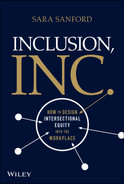Summary of Part 1
Chapter 1: Beyond Good Intentions
Some strides have been made toward workplace equality over the last 50 years, but over the last two decades, progress has stalled.
Common approaches to DEI have fallen short. Business leaders end up overwhelmed, trainings don't work or backfire, and statements of solidarity are called into question. Good intentions aren't enough.
The good news? When it comes to DEI, we've been doing it all wrong. The difference between businesses that break the DEI inertia and those who stay stuck is defined by one key perspective shift: Equity isn't personal. It's systemic.
Chapter 2: “But We've Always Done It This Way…”
Our unconscious mind drives up to 95 percent of our decision-making. It's where our biases are stored.
These biases often sabotage the most common approaches to DEI. When underestimated groups attempt to lean in, for example, they're treated differently than their peers. Because our perceptions of the ways people behave are built on a baseline of the ways we expect them to behave, we react negatively when those unconscious norms are disrupted.
We can't train our way out of these responses, and trainings often backfire. The more prejudiced people already are, the more likely they are to use the fact that they've attended a training to license less virtuous behavior later. This phenomenon is known as moral licensing.
Trainings also pose risk for underestimated individuals, who are sometimes treated as representative experts on their demographic's experiences.
Affinity groups can provide a sense of community, but too often they are treated as a substitute for inclusive workplace cultures. Providing a siloed space for shared identities does not counter organizational bias.
Chapter 3: Why Should We Care?
The workforce and consumers are rapidly diversifying. Employees and consumers care more about inclusion than previous generations, and investors are demanding diverse representation and equitable workplace policies.
As the demand for DEI has evolved, though, most companies' approaches haven't. This comes at a tremendous cost, keeping us from hiring the best person for the job or accurately assessing performance. Even when we believe we've created meritocracies, bias left unchecked sabotages our access to excellence.
When businesses do figure out how to include underestimated individuals, the strengths of the entire team are amplified. Teams with more diverse skill sets outperform teams stacked with traditional all-stars, strengthened by the benefits of collective intelligence.
A diverse workplace alone does not automatically yield these benefits. Companies must ditch outdated approaches to DEI and embrace mechanics that push them beyond diversity to inclusion.
Chapter 4: Shifting to a Systemic Perspective
Underestimated groups have been working in businesses that were never designed with them in mind. Physical workspaces accommodate men's bodies, dress codes default to Eurocentric standards of professionalism, and policies institutionalize workplace cultures that favor certain groups.
If exclusive design is the problem, inclusive design is the answer. A behavioral design approach to DEI means hitting the “pause” button to ask who the workplace was designed for, asking if these default settings still make sense, and making adjustments to optimize for inclusion.
We call these adjustments “cultural levers.” They can be adjusted to design bias out and equity in. They harm no one, remove barriers to merit-based decision making, and accommodate the realities of how people perform by tailoring environments to optimize results.
These “fixes” do not actually rid individuals of their biases; instead, they address the reality that we have them and can't train them away. Systemic changes take the onus off employees by debiasing processes, rather than people. Instead of changing mindsets, cultural levers change mechanics.
Chapter 5: Inclusion at the Intersections
The term “intersectionality” describes how class, race, age, gender, sexual orientation, and other aspects of identity “intersect” with one another or overlap. If you're standing at the intersection of two forms of exclusion, you're likely to be hit by both. If employers don't take an intersectional approach to DEI, they'll overlook hidden gaps that only widen over years.
When possible, try to gather intersectional perspectives. When you can't aggregate your data by intersections of identities, there are some underlying principles you can adhere to.
When gathering feedback:
- To avoid accommodating a homogeneous majority 100 percent of the time, rotate into second and third choices, and weight the answers of those who will be most impacted by policies.
- Provide space for open-ended responses.
- Ask, Who's in the room? Are those directly impacted by policy represented?
When implementing policy:
- Model the behavior yourself, especially if you are in a leadership position.
- Ask what criteria are driving your decision-making. When criteria aren't present, bias fills the void.
- Communicate why you're implementing a policy, and communicate universally.
When evaluating policy:
- Note who's showing up and who isn't. If participation is homogeneous, provide an opportunity for employees to state anonymously what would make them more likely to participate.
- Evaluate KPIs “upstream.” Evaluating indicators upstream that lead to different outcomes downstream will drive inclusive success.
It's time for part 2, “Adjusting Cultural Levers.”
